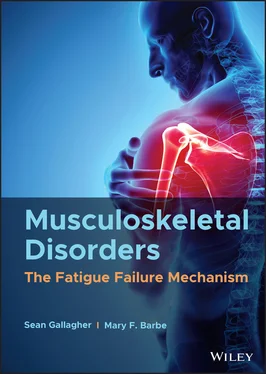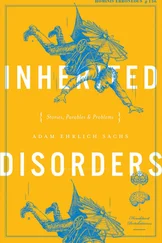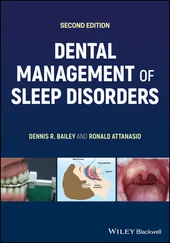Sean Gallagher - Musculoskeletal Disorders
Здесь есть возможность читать онлайн «Sean Gallagher - Musculoskeletal Disorders» — ознакомительный отрывок электронной книги совершенно бесплатно, а после прочтения отрывка купить полную версию. В некоторых случаях можно слушать аудио, скачать через торрент в формате fb2 и присутствует краткое содержание. Жанр: unrecognised, на английском языке. Описание произведения, (предисловие) а так же отзывы посетителей доступны на портале библиотеки ЛибКат.
- Название:Musculoskeletal Disorders
- Автор:
- Жанр:
- Год:неизвестен
- ISBN:нет данных
- Рейтинг книги:5 / 5. Голосов: 1
-
Избранное:Добавить в избранное
- Отзывы:
-
Ваша оценка:
- 100
- 1
- 2
- 3
- 4
- 5
Musculoskeletal Disorders: краткое содержание, описание и аннотация
Предлагаем к чтению аннотацию, описание, краткое содержание или предисловие (зависит от того, что написал сам автор книги «Musculoskeletal Disorders»). Если вы не нашли необходимую информацию о книге — напишите в комментариях, мы постараемся отыскать её.
Hands-on guidance and tools for the prevention of musculoskeletal injuries in the workplace Musculoskeletal Disorders: The Fatigue Failure Mechanism,
Musculoskeletal Disorders: The Fatigue Failure Mechanism
Musculoskeletal Disorders — читать онлайн ознакомительный отрывок
Ниже представлен текст книги, разбитый по страницам. Система сохранения места последней прочитанной страницы, позволяет с удобством читать онлайн бесплатно книгу «Musculoskeletal Disorders», без необходимости каждый раз заново искать на чём Вы остановились. Поставьте закладку, и сможете в любой момент перейти на страницу, на которой закончили чтение.
Интервал:
Закладка:
276 270
277 271
278 272
279 273
280 274
281 275
282 276
283 277
284 278
285 279
286 280
287 281
288 283
289 284
290 285
291 286
292 287
293 288
294 289
295 290
296 291
297 292
298 293
299 294
300 295
301 296
302 297
303 298
304 299
305 300
306 301
307 302
308 303
309 304
310 305
311 306
312 307
313 308
314 309
315 310
316 311
317 312
318 313
319 314
320 315
321 316
322 317
323 318
324 319
325 320
326 321
327 322
328 323
329 324
330 325
331 326
332 327
333 328
334 329
335 330
336 331
337 332
338 333
339 334
340 335
341 336
342 337
343 338
344 339
345 340
346 341
347 342
348 343
349 344
350 345
351 346
352 347
353 348
354 349
355 350
356 351
357 352
358 353
359 354
360 355
361 356
362 357
363 358
364 359
365 360
366 361
367 362
368 363
369 364
370 365
371 366
372 367
373 368
374 369
375 370
376 371
377 372
378 373
379 375
380 376
381 377
382 378
383 379
384 380
385 381
386 382
387 383
388 384
389 385
390 387
391 388
392 389
393 390
394 391
395 392
396 393
397 394
398 395
399 396
400 397
401 398
402 399
403 400
404 401
405 402
406 403
407 404
408 405
409 406
410 407
411 408
412 409
413 410
414 411
415 412
416 413
417 415
418 416
419 417
420 418
421 419
422 420
423 421
424 422
425 423
426 424
427 425
428 426
429 427
430 429
431 430
432 431
433 432
434 433
435 434
436 435
437 436
438 437
439 438
440 439
441 440
442 441
443 442
444 443
445 444
Musculoskeletal Disorders
The Fatigue Failure Mechanism
Sean Gallagher
Auburn University, Auburn, AL, USA
Mary F. Barbe
Temple University, Philadelphia, PA, USA

This edition first published 2022 © 2022 by John Wiley & Sons, Inc.
All rights reserved. No part of this publication may be reproduced, stored in a retrieval system, or transmitted, in any form or by any means, electronic, mechanical, photocopying, recording or otherwise, except as permitted by law. Advice on how to obtain permission to reuse material from this title is available at http://www.wiley.com/go/permissions.
The right of Sean Gallagher and Mary F. Barbe to be identified as the authors of this work has been asserted in accordance with law.
Registered Office John Wiley & Sons, Inc., 111 River Street, Hoboken, NJ 07030, USA
Editorial Office John Wiley & Sons, Inc., 111 River Street, Hoboken, NJ 07030, USA
For details of our global editorial offices, customer services, and more information about Wiley products visit us at www.wiley.com.
Wiley also publishes its books in a variety of electronic formats and by print‐on‐demand. Some content that appears in standard print versions of this book may not be available in other formats.
Limit of Liability/Disclaimer of Warranty In view of ongoing research, equipment modifications, changes in governmental regulations, and the constant flow of information relating to the use of experimental reagents, equipment, and devices, the reader is urged to review and evaluate the information provided in the package insert or instructions for each chemical, piece of equipment, reagent, or device for, among other things, any changes in the instructions or indication of usage and for added warnings and precautions. While the publisher and authors have used their best efforts in preparing this work, they make no representations or warranties with respect to the accuracy or completeness of the contents of this work and specifically disclaim all warranties, including without limitation any implied warranties of merchantability or fitness for a particular purpose. No warranty may be created or extended by sales representatives, written sales materials or promotional statements for this work. The fact that an organization, website, or product is referred to in this work as a citation and/or potential source of further information does not mean that the publisher and authors endorse the information or services the organization, website, or product may provide or recommendations it may make. This work is sold with the understanding that the publisher is not engaged in rendering professional services. The advice and strategies contained herein may not be suitable for your situation. You should consult with a specialist where appropriate. Further, readers should be aware that websites listed in this work may have changed or disappeared between when this work was written and when it is read. Neither the publisher nor authors shall be liable for any loss of profit or any other commercial damages, including but not limited to special, incidental, consequential, or other damages.
Library of Congress Cataloging‐in‐Publication Data applied for:
ISBN: 9781119640042
Cover image: © MDGRPHCS/Shutterstock
Cover design by Wiley
To Dad and Mom, who set a high bar; to Nancie for her constant love and support; and to Drew and Brendon for being wonderful and thoughtful sons.
Sean Gallagher
To my parents, who taught me how to dream; to Hugh, the love of my life, for his continued aid and support; and to Susan, my twin and other half of my soul, for always being my best friend, companion, and muse.
Mary F. Barbe
Preface
During the course of my [SG’s] doctoral work with Dr. William S. Marras, I became familiar with the work of researchers such as Adams, Cyron, Hutton, and Brinckmann who had performed ex vivo studies examining the effects of repeated stress on fatigue failure of spinal motion segments (Adams & Hutton, 1985; Brinckmann, Biggemann, & Hilweg, 1988; Cyron & Hutton, 1978). When the time came to select a dissertation topic, the option of performing an ex vivo fatigue failure study on spines at different levels of forward flexion was offered and I accepted the opportunity. The results of our research showed once again that spines subjected to repeated stress exhibited a classic fatigue failure response, and that the relationship is also affected by the degree of flexion of the motion segments adopted (Gallagher et al., 2007).
This research added to the existing body of evidence that cadaveric spinal motion segments fail in accordance with the mechanism of fatigue failure. However, though ex vivo fatigue failure data (on various musculoskeletal tissues) had been accumulating for some time, the implications of this mechanism regarding tissue damage were generally neither reflected in the development of musculoskeletal risk assessment tools nor in epidemiological studies examining musculoskeletal disorder risk factors. It is not entirely clear why this is the case, but it is the author's belief that researchers were reluctant to assume that this process would work in a similar manner in the setting of a complex biological system. This is understandable as no real evidence existed at that time that such a process was actually taking place in vivo .
Читать дальшеИнтервал:
Закладка:
Похожие книги на «Musculoskeletal Disorders»
Представляем Вашему вниманию похожие книги на «Musculoskeletal Disorders» списком для выбора. Мы отобрали схожую по названию и смыслу литературу в надежде предоставить читателям больше вариантов отыскать новые, интересные, ещё непрочитанные произведения.
Обсуждение, отзывы о книге «Musculoskeletal Disorders» и просто собственные мнения читателей. Оставьте ваши комментарии, напишите, что Вы думаете о произведении, его смысле или главных героях. Укажите что конкретно понравилось, а что нет, и почему Вы так считаете.




![Ally Carter - [Gallagher Girls 02 ] - Cross My Heart & Hope To Spy](/books/262178/ally-carter-gallagher-girls-02-thumb.webp)







![John Bruce - The Lettsomian Lectures on Diseases and Disorders of the Heart and Arteries in Middle and Advanced Life [1900-1901]](/books/749387/john-bruce-the-lettsomian-lectures-on-diseases-and-disorders-of-the-heart-and-arteries-in-middle-and-advanced-life-1900-1901-thumb.webp)